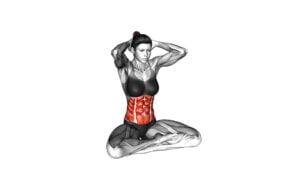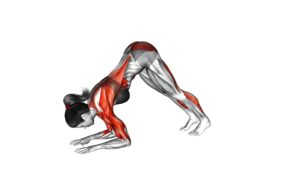Sphinx Pose (female) – Video Exercise Guide & Tips

Get ready to strengthen your core and improve flexibility with Sphinx Pose! In this video exercise guide, you'll find tips and techniques specifically tailored for females.
Watch This Exercise Video
By properly aligning your body and engaging your muscles, you'll experience the full benefits of this pose. Beginners can modify the pose to suit their level, while advanced practitioners can challenge themselves with variations.
Follow these instructions to make the most out of your practice and feel the transformative effects.
Let's get started!
Key Takeaways
- Sphinx Pose relieves stress and promotes mental clarity.
- It strengthens and stretches the back, shoulders, and abdomen.
- Beginners can modify the pose by using a bolster or pillow for support.
- Advanced variations include Forearm Sphinx Pose, One-Legged Sphinx Pose, Sphinx Twist, and Sphinx with Backbend.
Benefits of Sphinx Pose
Discover the numerous benefits of practicing Sphinx Pose, a gentle and effective yoga posture that can greatly improve your strength and flexibility. Sphinx Pose, also known as Salamba Bhujangasana, is a beginner-friendly pose that offers a wide range of healing benefits for both the body and mind.
One of the primary healing benefits of Sphinx Pose is its ability to relieve stress and promote mental clarity. As you lie on your stomach with your forearms on the ground, the gentle backbend created by this pose helps to open up your chest and release tension in your upper body. This can help to calm your mind and reduce anxiety, allowing you to experience a greater sense of mental clarity and focus.
Additionally, Sphinx Pose is known to strengthen and stretch the muscles in your back, shoulders, and abdomen. By engaging your core and slowly lifting your chest off the ground, you can build strength in your spinal muscles and improve your overall posture. This pose also helps to increase the flexibility of your spine, improving your range of motion and reducing the risk of back pain.
Incorporating Sphinx Pose into your regular yoga practice can have profound effects on both your physical and mental well-being. By experiencing the healing benefits of this pose, you can cultivate a greater sense of mental clarity and improve your overall strength and flexibility.
How to Properly Align Your Body
To properly align your body in Sphinx Pose, position yourself on your stomach with your forearms on the ground. Start by extending your legs behind you, keeping them hip-width apart. Engage your core muscles and press your pubic bone into the floor. Place your elbows directly under your shoulders, allowing your forearms to rest on the ground parallel to each other.
To maintain proper alignment, make sure your shoulders are relaxed and away from your ears. Keep your neck long and in line with your spine, avoiding any excessive tilting or lifting. Gently press your chest forward, allowing your sternum to lift slightly off the ground.
Common mistakes to avoid include sinking your shoulders or collapsing your chest. It's important to maintain a neutral spine and avoid excessive arching or rounding. Avoid tensing your glutes or squeezing your buttocks, as this can cause unnecessary strain.
Remember to breathe deeply and relax your body as you hold Sphinx Pose. Focus on elongating your spine and opening your chest.
With proper alignment techniques and attention to detail, Sphinx Pose can be a beneficial and effective posture for improving posture, strengthening the back, and relieving lower back pain.
Modifications for Beginners
If you're a beginner, you can modify Sphinx Pose by using a bolster or pillow to support your upper body. This modification helps to make the pose more accessible and comfortable for beginners who may not have the flexibility or strength to hold the full pose yet.
To do this modification, start by lying on your stomach with your legs extended behind you. Place the bolster or pillow under your forearms, allowing your chest and upper body to rest on it. Your elbows should be directly under your shoulders. Relax your neck and let your forehead rest on the mat or the floor.
Take a few deep breaths in this modified Sphinx Pose, allowing your body to relax and settle into the support of the bolster or pillow. As you gain strength and flexibility, you can gradually reduce the height of the bolster or pillow until you can comfortably practice the full Sphinx Pose.
Remember to listen to your body and only go as far as feels comfortable for you. With regular practice, you'll gradually build the necessary strength and flexibility to do the pose without any modifications.
Advanced Variations to Challenge Yourself
To challenge yourself, try incorporating advanced variations of Sphinx Pose into your practice. These modifications are specifically designed for experienced yogis who are looking to take their practice to the next level. Here are four variations to help you challenge yourself:
- Forearm Sphinx Pose: Instead of resting on your hands, lower down onto your forearms while maintaining the elongation of your spine. This variation increases the intensity of the pose and requires more core strength and stability.
- One-Legged Sphinx Pose: Lift one leg off the ground while keeping the other leg grounded. This variation challenges your balance and engages your glutes and hamstrings.
- Sphinx Twist: From Sphinx Pose, bring one arm across your body and place it on the opposite side of your body. Rotate your torso towards the side of the extended arm, deepening the stretch in your spine and shoulders.
- Sphinx with Backbend: Extend your arms out in front of you and lift your chest off the ground, arching your back. This variation opens up your chest and strengthens your back muscles.
Remember to listen to your body and only attempt these advanced variations if you feel comfortable and confident in your practice. Always warm up properly and consult with a qualified yoga instructor if you have any concerns or questions.
Tips for Getting the Most Out of Your Practice
Get the most out of your practice by incorporating these helpful tips.
To improve flexibility in Sphinx Pose, focus on deepening your backbend gradually over time. Start by gently lifting your chest off the ground and lengthening your spine, and then gradually increase the height of your chest as you become more comfortable. Remember to engage your core and keep your shoulders relaxed to avoid straining your lower back.
Incorporating breathwork can also enhance your practice. As you lift your chest in Sphinx Pose, take slow and deep breaths, focusing on expanding your ribcage and filling your lungs with air. Exhale fully, emptying your lungs completely before taking the next breath. This conscious breathing will help to calm your mind and bring a sense of relaxation to your practice.
To deepen the stretch in your lower back, try gently pressing your hands into the ground and lengthening your arms. This will create a slight traction in your spine, allowing for a deeper opening in the front of your body. Remember to listen to your body and only go as far as feels comfortable for you.
Frequently Asked Questions
What Are the Common Mistakes to Avoid While Performing Sphinx Pose?
When performing Sphinx Pose, it's important to be aware of common mistakes and focus on proper alignment. Avoid sinking into your lower back or rounding your shoulders forward. Instead, engage your core and lengthen your spine.
Keep your elbows directly under your shoulders and relax your neck. Remember to breathe deeply and listen to your body.
Can Sphinx Pose Help in Relieving Lower Back Pain?
Sphinx pose can be beneficial for relieving lower back pain. By gently stretching the spine and opening the chest, this pose helps to alleviate tension and tightness in the lower back. Additionally, sphinx pose improves posture and strengthens the muscles in the back and core.
To vary the pose and target different areas, you can try different arm positions or add a gentle twist. Remember to listen to your body and modify the pose as needed.
Is Sphinx Pose Safe During Pregnancy?
During pregnancy, it's important to modify your yoga practice to ensure safety.
Sphinx pose can be safe during pregnancy if done correctly. By propping yourself up on your forearms instead of fully extending your arms, you can reduce pressure on your abdomen.
This pose can help in relieving lower back pain and improving posture.
However, it's always best to consult with your healthcare provider or a prenatal yoga instructor before attempting any new poses to ensure they're safe for you and your baby.
Are There Any Specific Breathing Techniques to Follow While Practicing Sphinx Pose?
When practicing Sphinx Pose, it's important to focus on your breath. Take deep inhales and exhales, allowing your breath to flow naturally.
As you lift your chest and engage your core, inhale to create space in your torso. Exhale to deepen the stretch and release tension.
How Long Should One Hold Sphinx Pose to Experience Its Benefits?
To experience the benefits of Sphinx Pose, hold it for at least 3-5 minutes. This pose helps to strengthen your back muscles and improve posture.
If you're a beginner, you can modify Sphinx Pose by placing a bolster or folded blanket under your chest for extra support.
Adding Sphinx Pose to your yoga routine can also help relieve stress and anxiety while opening up your heart and lungs.
Conclusion
Incorporating Sphinx Pose into your exercise routine can provide numerous benefits for your body and mind. By aligning your body properly and making use of modifications, beginners can gradually build strength and flexibility. For those seeking a challenge, advanced variations can push your limits.
Remember to follow these tips to get the most out of your practice and make the most of this beneficial yoga pose. Start with the basics and progress at your own pace to achieve optimal results.

Author
Years ago, the spark of my life’s passion ignited in my mind the moment I stepped into the local gym for the first time. The inaugural bead of perspiration, the initial endeavor, the very first surge of endorphins, and a sense of pride that washed over me post-workout marked the beginning of my deep-seated interest in strength sports, fitness, and sports nutrition. This very curiosity blossomed rapidly into a profound fascination, propelling me to earn a Master’s degree in Physical Education from the Academy of Physical Education in Krakow, followed by a Sports Manager diploma from the Jagiellonian University. My journey of growth led me to gain more specialized qualifications, such as being a certified personal trainer with a focus on sports dietetics, a lifeguard, and an instructor for wellness and corrective gymnastics. Theoretical knowledge paired seamlessly with practical experience, reinforcing my belief that the transformation of individuals under my guidance was also a reflection of my personal growth. This belief holds true even today. Each day, I strive to push the boundaries and explore new realms. These realms gently elevate me to greater heights. The unique combination of passion for my field and the continuous quest for growth fuels my drive to break new ground.







